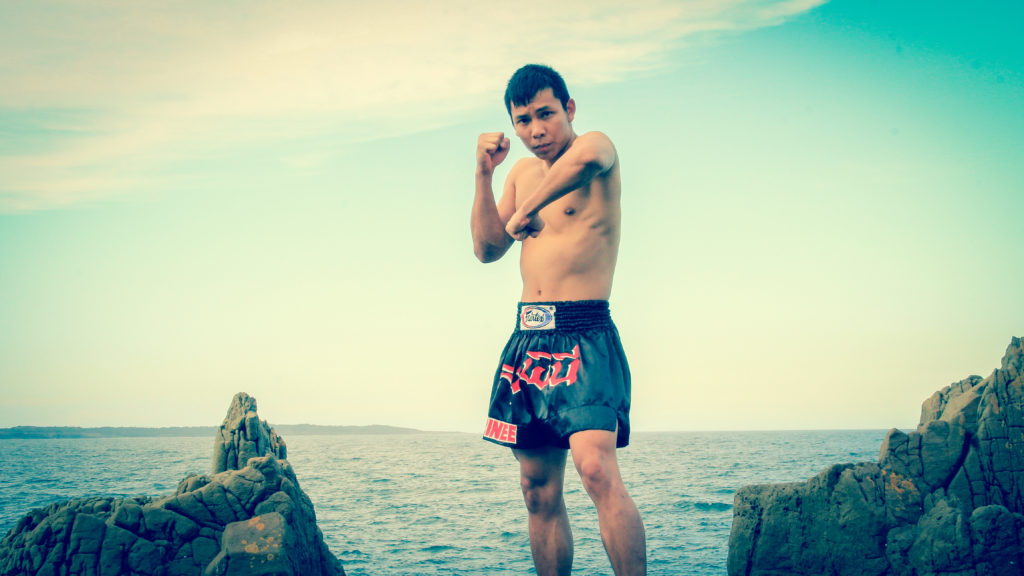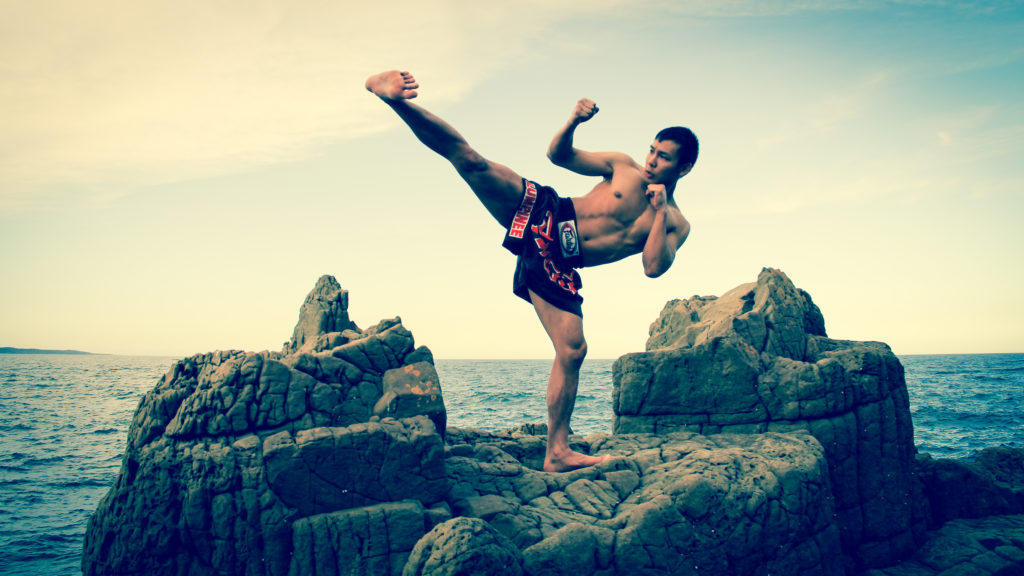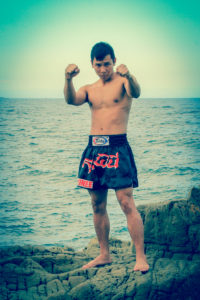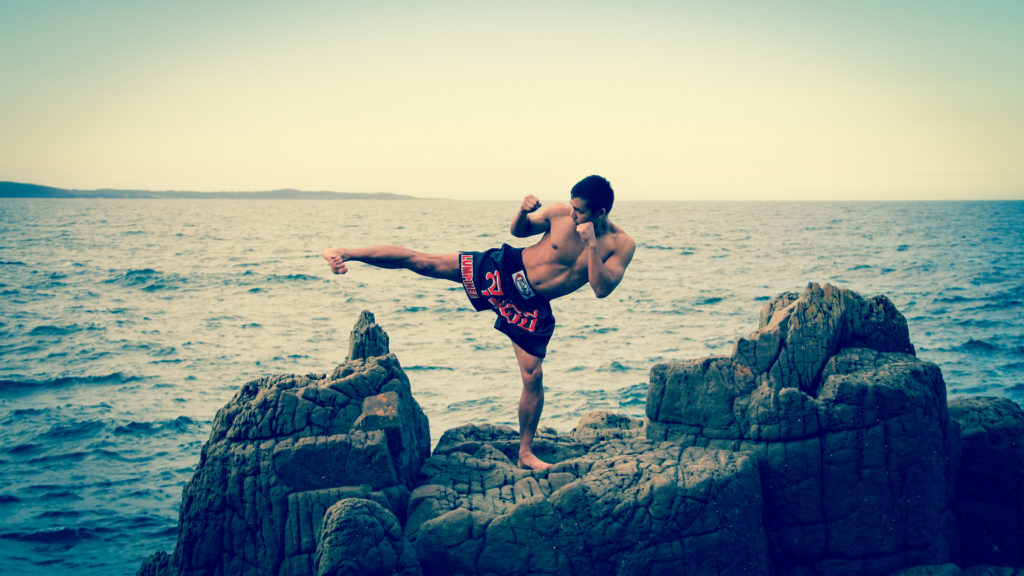Muay Thai is a form of hard martial art practiced in large parts of the world. Muay Thai has a long history in Thailand and is the country’s national sport. Traditional Muay Thai practiced today varies significantly from the ancient art Muay Boran and uses kicks and punches in a ring with gloves similar to those used in Western boxing.
Muay Thai is referred to as "The Art of Eight Limbs", as the hands, shins, elbows, and knees are all used extensively in this art. A practitioner of Muay Thai (nak muay) has the ability to execute strikes using eight “points of contact,” as opposed to “two points” (fists) in Boxing and “four points” (Karate) used in the primarily sport-oriented forms of martial arts.
Muay Thai techniques
The Art of Eight Limbs
Muay Thai techniques
The Art of Eight Limbs
In its original form, Muay Thai consisted of an arsenal of nine weapons – the head, fists, elbows, knees and feet – known collectively as na-wa arwud. However in modern Muay Thai, both amateur and professional, headbutting an opponent is no longer allowed.
To strike and bind the opponent for both offensive and defensive purposes, small amounts of stand-up grappling are used: the clinch. Formal Muay Thai techniques are divided into two groups: Mae Mai or major techniques and Luk Mai or minor techniques. Muay Thai is often a fighting art of attrition, where opponents exchange blows with one another. This is certainly the case with traditional stylists in Thailand, but is a less popular form of fighting in the contemporary world fighting circuit. With the success of Muay Thai in mixed martial arts fighting, it has become the de facto martial art of choice for competitive stand-up fighters. As a result, it has evolved and incorporated much more powerful hand striking techniques used in western style boxing and the Thai style of exchanging blow for blow is no longer favorable.
Note: when Muay Thai fighters compete against fighters of other styles (and if the rules permit it), they almost invariably emphasise elbow (sok) and knee (kao) techniques to gain a distinct advantage in fighting.
Almost all techniques in Muay Thai use the entire body movement, rotating the hip with each kick, punch, and block. The rotation of the hips in Muay Thai techniques, and intensive focus on “core muscles” (such as abdominal muscles and surrounding muscles) is very distinctive and is what sets Muay Thai apart from other styles of martial arts.
The punch techniques in Muay Thai were originally quite simple being crosses and a long (or lazy) circular strike made with a straight (but not locked) arm and landing with the heel of the palm. Cross-fertilisation with Western boxing and western martial arts mean the full range of western boxing punches are now used: jab, straight right/cross, hook, uppercut, shovel and corkscrew punches and overhands as well as hammer fists and back fists.
As a tactic, body punching is used less in Muay Thai than most other striking martial arts to avoid exposing the attacker’s head to counter strikes from knees or elbows. To utilise the range of targeting points, in keeping with the Theory of Muay Thai – Centre Line, the advocate can use either Western or Thai stance which allows for either long range or short range attacks to be undertaken effectively without compromising guard.
Elbow
Tee sok
Elbow
Tee sok
The elbow can be used in several ways as a striking weapon: horizontal, diagonal-upwards, diagonal-downwards, uppercut, downward, backward-spinning and flying. From the side it can be used as either a finishing move or as a way to cut the opponent’s eyebrow so that blood might block his vision. The blood also raises the opponent’s awareness of being hurt which could affect his performance. This is the most common way of using the elbow. The diagonal elbows are faster than the other forms, but are less powerful. The uppercut and flying elbows are the most powerful, but are slower and easier to avoid or block. The downward elbow is usually used as a finishing move.
| English | Thai | Transliteration |
|---|---|---|
| Elbow Slash | ศอกตี | Sok Tee |
| Horizontal Elbow | ศอกตัด | Sok Tud |
| Uppercut Elbow | ศอกงัด | Sok Ngud |
| Forward Elbow Thrust | ศอกพุ่ง | Sok Poong |
| Reverse Horizontal Elbow | ศอกเหวี่ยงกลับ | Sok Wiang Glub |
| Spinning Elbow | ศอกกลับ | Sok Glub |
| Elbow Chop | ศอกสับ | Sok Sub |
| Double Elbow Chop | ศอกกลับคู่ | Sok Glub Koo |
| Mid-Air Elbow Strike | กระโดดศอก | Gra-dode Sok |
There is also a distinct difference between a single elbow and a follow-up elbow. The single elbow is an elbow move independent from any other move, whereas a follow-up elbow is the second strike from the same arm, being a hook or straight punch first with an elbow follow-up. Such elbows, and most other elbows, are used when the distance between fighters becomes too small and there is too little space to throw a hook at the opponent’s head. Elbows can also be utilised to great effect as blocks or defences against, for example, spring knees, side body knees, body kicks or punches.

Kicking
Teh
Kicking
Teh
| English | Thai | Transliteration |
|---|---|---|
| Straight Kick | เตะตรง | Teh Trong |
| Roundhouse Kick | เตะตัด | Teh Tud |
| Diagonal Kick | เตะเฉียง | Teh Chiang |
| Half-Shin, Half-Knee Kick | เตะครึ่งแข้งครึ่งเข่า | Teh Krueng Kheng Krueng Kao |
| Spinning Heel Kick | เตะกลับหลัง | Teh Glub Lang |
| Down Roundhouse Kick | เตะกด | Teh Kod |
| Axe Heel Kick | เตะเข่า | Teh Khao |
| Jump Kick | กระโดดเตะ | Gra-dode Teh |
| Step-Up Kick | เขยิบเตะ | KhaYiep Teh |
If a round house kick is attempted by the opponent the Muay Thai fighter will normally block with his shin. Thai boxers are trained to always connect with the shin. While sensitive in an unconditioned practitioner, the shin is the strongest part of the leg for experienced Muay Thai fighters. The foot contains many fine bones and is much weaker. A fighter may end up hurting himself if he tries to strike with his foot or instep. The two most common kicks in Muay Thai are known as the teep (literally “foot jab,”), and the Teh (kick)chiang (kicking upwards in the shape of a triangle cutting under the arm and ribs) or angle kick. The Muay Thai angle kick has been widely adopted by fighters from other martial arts. The angle kick uses a rotational movement of the entire body. The angle kick is superficially similar to a karate roundhouse kick, but omits the rotation of the lower leg from the knee used in other striking martial arts like Karate or Taekwondo. The angle kick draws its power entirely from the rotational movement of the body. Many Muay Thai fighters use a counter rotation of the arms to intensify the power of this kick.
Muay Thai also includes other varieties of kicking, such as the axe kick, side kick or spinning back kick etc. These kicks are only used in bouts by some fighters. It is worth noting that a side kick is performed differently in Muay Thai than the traditional side kick of other martial arts. In Muay Thai, a side kick is executed by first raising the knee of the leg that is going to kick in order to convince the opponent that the executor is going to perform a teep or front kick. The hips are then shifted to the side to the more traditional side kick position for the kick itself. The “fake-out” almost always precedes the kick in Muay Thai technique.
| English | Thai | Transliteration |
|---|---|---|
| Straight Knee Strike | เข่าตรง | Kao Trong |
| Diagonal Knee Strike | เข่าเฉียง | Kao Chiang |
| Curving Knee Strike | เข่าโค้ง | Kao Kong |
| Horizontal Knee Strike | เข่าตัด | Kao Tud |
| Knee Slap | เข่าตบ | Kao Tob |
| Flying Knee Strike | เข่าลอย | Kao Loi |
| Step-Up Knee Strike | เข่าเหยียบ | Kao Yiep |

Foot-thrust
Teep
Foot-thrust
Teep
Foot-Thrusts also known as Push Kicks or literally “foot jabs” are one of the most common techniques used in Muay Thai. Teeps are different from any other Muay Thai technique in terms of objective to use. Foot-thrusts are mainly used as a defensive technique to control distance, block attacks, and get an opponent off balance. Foot-Thrusts should be thrown quickly but yet with enough force to knock an opponent off balance.
| English | Thai | Transliteration |
|---|---|---|
| Straight Foot-Thrust | ถีบตรง | Teep Trong |
| Sideways Foot-Thrust | ถีบข้าง | Teep Kang |
| Reverse Foot-Thrust | ถีบกลับหลัง | Teep Glub Lang |
| Slapping Foot-Thrust | ถีบตบ | Teep Tob |
| Jumping Foot-Thrust | กระโดดถีบ | Gra-dode Teep |
Clinch
Clinch
In Western Boxing the two fighters are separated when they clinch; in Muay Thai, however, they are not. It is often in the clinch where knee and elbow techniques are used. The front clinch should be performed with the palm of one hand on the back of the other. There are three reasons why the fingers must not be intertwined:
- In the ring fighters are wearing boxing gloves and cannot intertwine their fingers.
- The Thai front clinch involves pressing the head of the opponent downwards, which is easier if the hands are locked behind the back of the head instead of behind the neck. Furthermore the arms should be putting as much pressure on the neck as possible.
- A fighter may incur an injury to one or more fingers if they are intertwined, and it becomes more difficult to release the grip in order to quickly elbow the opponent’s head.
A correct clinch also involves the fighter’s forearms pressing against the opponent’s collar bone while the hands are around the opponent’s head rather than the opponent’s neck.
The general way to get out of a clinch is to push the opponent’s head backwards or elbow him or her, as the clinch requires both participants to be very close to one another. Additionally, the non-dominant clincher can try to “swim” his or her arm underneath and inside the opponent’s clinch, establishing the previously non-dominant clincher as the dominant clincher.
Muay Thai has several other variants of the clinch, including:
- arm clinch, where one or both hands controls the inside of the defender’s arm(s) and where the second hand if free is in the front clinch position, this clinch is used to briefly control the opponent before applying a knee strike or throw
- side clinch, one arm passing around the front of the defender with the attacker’s shoulder pressed into the defender’s arm pit and the other arm passing round the back which allows the attacker to apply knee strikes to the defender’s back or to throw the defender readily
- low clinch, with both controlling arms passing under the defender’s arms, which is generally used by the shorter of two opponents

Defence
Against Attacks
Defence
Against Attacks
Defences in Muay Thai are categorised in 6 groups:
| Group | Description |
|---|---|
| 1. Blocking | defender’s hard blocks to stop a strike in its path so preventing it reaching its target, (eg the Shin Block described in more detail below) |
| 2. Redirection | defender’s soft parries to change the direction of a strike (eg a downwards tap to a jab) so that it misses the target |
| 3. Avoidance | moving a body part out of the way or range of a strike so the defender remains in range for a counter-strike, eg defender laying the head back from the attacker’s high roundhouse kick and then immediately counter-attacking with a side kick from the front leg |
| 4. Evasion | moving the body out of the way or range of a strike so the defender has to move close again to counter-attack, eg defender jumping back from attacker’s kicks |
| 5. Disruption | Pre-empting an attack. eg with defender using disruptive techniques like jab, teep or low angle kick (to the inside of the attacker’s front leg) as the attacker attempts to close distance |
| 6. Anticipation | Defender catching a strike (eg catching an angle kick to the body) or countering it before it lands (eg defender’s low kick to the supporting leg below as the attacker iniates a high angle kick |

Muay Thai History